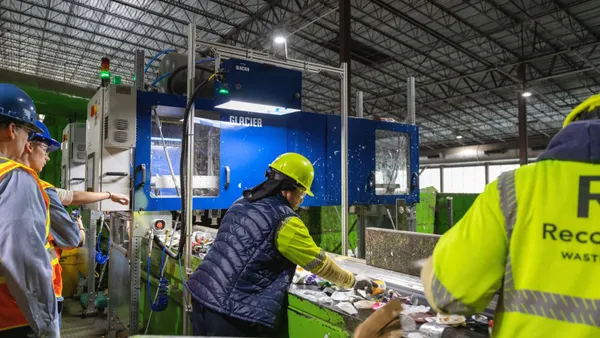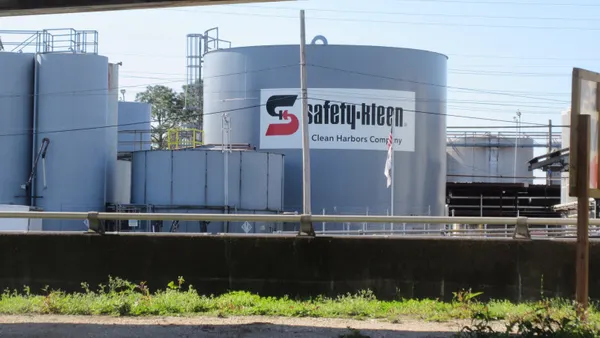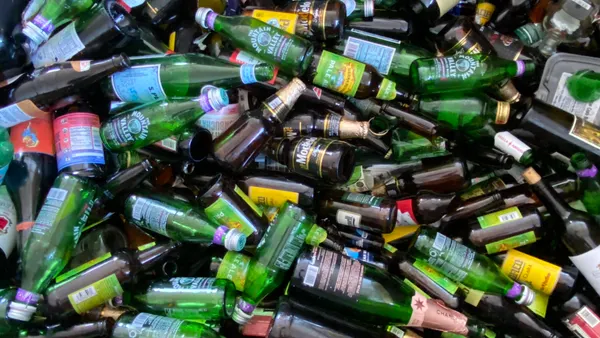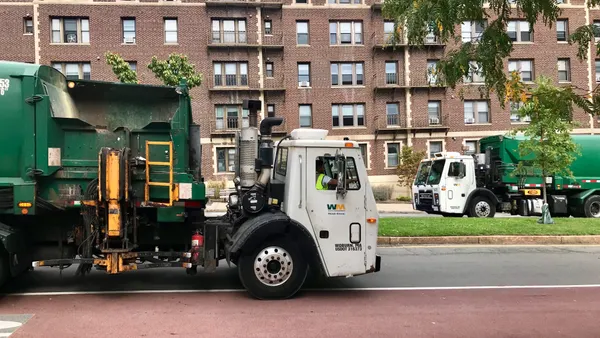One year after the federal government announced a national goal of cutting food waste in half by 2030, the recycling industry is still figuring out how it fits into the equation.
The targets set by the EPA and the USDA sound straightforward: reduce the amount of food waste sent to landfills by 109.4 pounds per person and reduce loss at the retail and consumer levels by about 66 billion pounds.
Yet tackling the largest portion of the waste stream will likely require new government policy, supply chain restructuring, infrastructure investment and a shift in consumer behavior more complex than the advent of curbside recycling.
In the year since the goal was announced, awareness around the issue has increased due to media attention, conferences, educational campaigns and other outreach efforts. The EPA released a "Call to Action" which identified opportunities for stakeholder involvement, a home food waste reduction toolkit and other materials. The USDA released social media education tools, organized a food waste reduction challenge at major terminal produce markets and increased funding for research in the 2015-2020 funding cycle from $3 million to $4.5 million.
The scope of this work extends far beyond the waste and recycling industry, but everyone agrees that it has a key role to play. When asked what that role looked like, EPA Press Secretary Monica Lee provided the following response:
"Similar to the recycling revolution of bottles, cans and paper in the 1990s, companies in the materials management arena have an opportunity to turn food into a resource leading to an economically and environmentally sustainable business model. Already communities across the United States have turned to the materials management and recycling industry to maximize the value of and develop new innovative solutions for food waste – such as improving infrastructure to include commercial and residential composting programs and strategic placement of anaerobic digesters."
While 2030 is still 14 years away, many people in the field have said they would like to see more information on what needs to happen along the way. At a time when municipalities and haulers are already facing tough commodity markets for recyclables, figuring out how to handle food waste is still a very open question.
Identifying industry responsibility
As indicated by the EPA, food waste can indeed be an economically valuable resource and many companies have already been taking advantage of this. Yet based on the EPA's food recovery hierarchy the industry is also not necessarily meant to be the first to handle this material. Source reduction, feeding people and feeding animals are all seen as more preferable options.
"The industry is the recipient of last resort for food waste and we need to remind policy makers and others that we’re service providers," said David Biderman, CEO of the Solid Waste Association of North America. "It’s my hope that there will be less food loss generated from farm to table and as a result there will be less of a need to focus on the table to disposal side."
Biderman also recognized that members of his association and others in the industry will still have an important role to play in handling what material does make its way down the hierarchy. Yet that’s where it can get complicated.
"On the recycling side, the focus was on processing material and diverting material. On the food waste side I think there’s a difference in that we're encouraging less generation of the material itself," he said.
Encouraging less generation of a material while still offering collection for it is an interesting dynamic, but one that makes sense based on the costs associated with it.
"Food basically picks up costs as it moves down the value chain and by the time it gets to end of life it’s really hard for our customers to manage and it tends to be pretty expensive as well," said Susan Robinson, Waste Management’s director of public affairs.
Waste Management offers organic collection and processing options in many parts of the country, though the company has also taken a more strategic approach to where it does so. In order to make collection programs beneficial for all sides, the company aims to have contracts that include some form of municipal responsibility or consumer incentive to help offset costs.
The company recently released a study that measured the environmental benefits of diverting various recyclable materials which found that certain types of organic streams are more valuable than others.
"We have the opportunity to use what we've learned from recycling," said Robinson. "It isn’t necessarily the highest number of tons, it’s the best quality of material for that end market."
The issue of infrastructure
Because of its size, Waste Management also has an advantage in terms of owning processing infrastructure. Yet for some haulers or municipalities that can’t afford a large investment in processing equipment, or don’t have access to it within a reasonable distance, plans can be complicated. This is part of the reason that curbside collection or drop-off programs exist in major cities — Seattle, San Francisco, New York — but are more limited in the rest of the country.
Will Sagar, executive director of the Southeast Recycling Development Council, said the scarcity of processing options is a big factor in the limited amount of collection programs in his region.
"The infrastructure is woefully inadequate," said Sagar. "The problem we have is even in the markets where they exist, their penetration is so shallow or so scattered that the cost for collection prohibits a lot of people from entering into participation."
Making these programs work will require high participation rates so routes can be as dense as possible as well as better analytics and infrastructure planning to figure out where they make the most sense. Rather than jump to the approach of universal curbside collection, Sagar said the industry should take this moment to plan more strategically than it did with recycling.
"We have the opportunity now in the absence of food collection infrastructure to be much more efficient and build it right," he said.
Building new systems from scratch
The question of who should invest in the composting facilities, anaerobic digesters and other technologies needed to make this work remains unanswered. In some states, regulations or incentives have encouraged developments. Others leave it up to municipalities or haulers to make the choice.
In an effort to help clarify what these processing choices look like, a collaboration called ReFED released a "Roadmap to Reduce U.S. Food Waste" outlining various options and their potential benefits. While the potential financial savings per ton drop significantly on the bottom end of the hierarchy compared to solutions at the supply chain level, processing is still an essential part of the system.
Sarah Vared, ReFED’s executive director, said financial details vary by region but the key is to limit transportation costs and have a more distributed network of options.
"The disposal of food waste is a local issue," she said. "You really need to have a municipal systems approach."
Vared pointed to a resolution that was recently passed by the U.S. Conference of Mayors to increase investment in prevention, recovery and recycling in cities as a positive sign. She also noted that the number of innovative companies and organizations working on this issue has risen within the past year to more than 300.
Looking at lessons from existing organics recovery programs, such as in Seattle, Vared said the best ones seemed to find ways for generators, haulers and processors to work in unison rather than independently.
This approach has been shown most recently in Maine, where the nonprofit solid waste corporation ecomaine just launched a new organics recovery program for its member communities. The company recently signed a five-year contract with a local anaerobic digestion facility that had shown a willingness to invest in pre-processing technology, though the move has still required an investment on ecomaine’s side, too.
"The only way to get this program rolling was for us to cover the cost associated with it," said ecomaine CEO Kevin Roche.
In an effort to encourage participation, ecomaine has lowered its tipping fees for organics to $55 per ton — as compared to $70 for refuse — and is working with businesses to establish a steady stream of material first before moving into residential.
While Roche said he could make more money in the short-term from sending material to his landfill, he doesn't believe it's a good long-term solution. He sees the organics operation as a key part of ecomaine’s operation — which also includes recycling and a waste-to-energy facility — and encouraged other companies to think the same way.
"We need to make sure that these programs can’t be done on the cheap, because if they’re done on the cheap the risk of failure is so much higher," said Roche.
Rethinking roles
Just as municipalities and haulers have had to rethink the way they collect food scraps, they may need to rethink their place in the waste hierarchy, too.
"From an early phase we are linking the supply chain from producers, manufacturers, the municipalities, collectors and processors," said Robinson. "End of life can't do it alone. It really requires all of us working together."
To that end, Waste Management plans to expand its work with local food banks and community organizations to become more involved in the larger picture and this has also been seen from other companies around the country.
The USDA aims to help organize some of these efforts by creating the National Virtual Resource Center on Food Loss and Waste, a repository of information on the vast array of work being done on this issue at all levels, in collaboration with many different organizations. The EPA is also working on this project and others, including a planned forum in the Midwest next year.
Other organizations working to understand and control the waste that’s happening at the top of the hierarchy include the World Resources Institute, the Food Waste Reduction Alliance, the Harvard Food Law and Policy Clinic, and the Natural Resources Defense Council. Legislation around food waste was discussed in a congressional hearing this spring and new reports from various groups are expected out in the coming months.
With so much different work happening across so many different sectors, those involved say the only way to pull off this 2030 goal is full-scale collaboration.
"We're at the stage of really setting the foundation for progress to be made moving forward," said Dana Gunders, a staff scientist for the NRDC. “It’s nobody’s job to do the top of hierarchy right now.”
Gunders is one of the driving forces behind the "Save the Food" ad campaign and other efforts aimed at changing the way people think about food waste. While she would also like to see more government action through funding and other areas, she says the waste industry is uniquely positioned to start educating its customers now.
Following curbside recycling and e-waste collection, the rapidly growing focus on this new source of material marks one of the biggest recent shifts in the waste sector. Regardless of what happens between now and 2030 it's something that the industry will have to deal with one way or another.
"There is a role for each of us to play," said Gunders. "The waste industry may call itself that right now, but I think to the extent that we can all be looking upstream and finding our roles throughout the hierarchy the better off we’ll all be."













